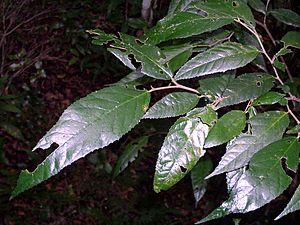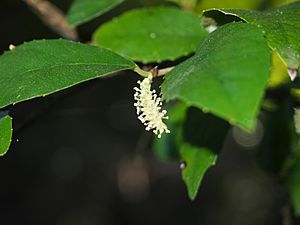Streblus brunonianus facts for kids
Quick facts for kids Streblus brunonianus |
|
|---|---|
 |
|
| A whalebone tree growing in a jungle near the Allyn River, Barrington Tops, Australia | |
| Scientific classification | |
| Genus: |
Streblus
|
| Species: |
brunonianus
|
| Synonyms | |
|
|
The whalebone tree, also known as Streblus brunonianus, is a small tree that belongs to the fig family. You can often find it growing in different types of rainforests, especially near streams.
This tree grows in many places, from Milton in New South Wales all the way up to the Cape York Peninsula in northern Australia. It also lives in New Guinea and other islands in the Pacific Ocean.
People call it by other names too, like white handlewood, axe-handle wood, grey handlewood, and prickly fig.
Contents
What Does the Whalebone Tree Look Like?
The whalebone tree is usually a large bush or a small tree. Sometimes, it can grow much bigger, reaching up to 30 meters (about 98 feet) tall. Its trunk can be about 40 centimeters (about 16 inches) wide. The trunk is usually round or has flat edges. Its bark is brown and has vertical bumps or lines on it.
Leaves of the Whalebone Tree
The leaves of this tree are thin and have a long, pointed tip. They are usually 5 to 8 centimeters (about 2 to 3 inches) long. They grow one after another on the stem and are simple in shape. Their edges often have small teeth. The bottom of the leaf feels a bit hairy, while the top is shiny and a medium green color. You can see the leaf veins more clearly on the underside.
Flowers and Fruit
The whalebone tree produces flowers from September to May. The male flowers grow on long spikes. The female flowers appear in small groups or on shorter spikes.
The fruit ripens between January and May. It is a yellow berry, about 4 to 6 millimeters (less than half an inch) long. Inside, there are round, pale seeds, about 3 millimeters (about 0.1 inches) wide.
Life Cycle and Reproduction
It's quite easy to grow new whalebone trees from fresh seeds. The seeds usually sprout within seven weeks.
Many birds enjoy eating the fruit of the whalebone tree. These include the Brown cuckoo-dove, the green catbird, Lewin's honeyeater, the Rose-crowned fruit dove, and the topknot pigeon.
See Also
 In Spanish: Streblus brunonianus para niños
In Spanish: Streblus brunonianus para niños


